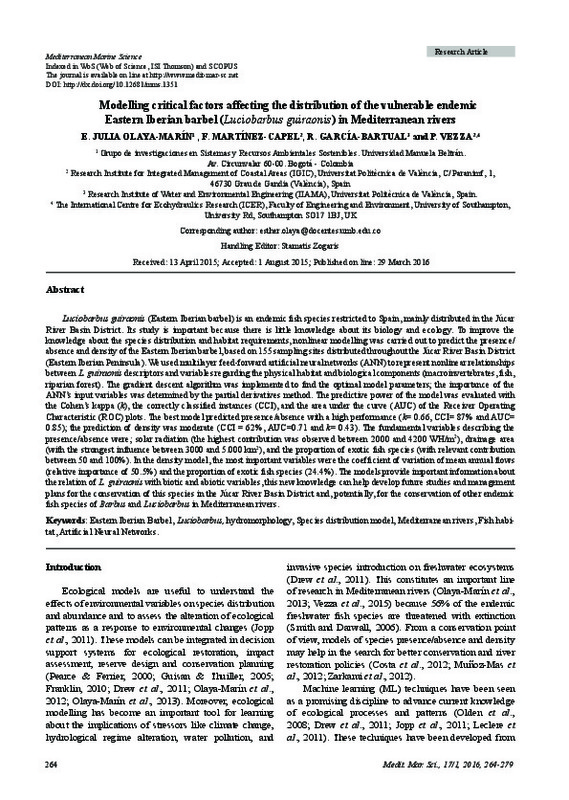|
Resumen:
|
[EN] Luciobarbus guiraonis (Eastern Iberian barbel) is an endemic fish species restricted to Spain, mainly distributed in the Júcar River Basin District. Its study is important because there is little knowledge about its ...[+]
[EN] Luciobarbus guiraonis (Eastern Iberian barbel) is an endemic fish species restricted to Spain, mainly distributed in the Júcar River Basin District. Its study is important because there is little knowledge about its biology and ecology. To improve the knowledge about the species distribution and habitat requirements, nonlinear modelling was carried out to predict the presence/absence and density of the Eastern Iberian barbel, based on 155 sampling sites distributed throughout the Júcar River Basin District (Eastern Iberian Peninsula). We used multilayer feed-forward artificial neural networks (ANN) to represent nonlinear relationships between L. guiraonis descriptors and variables regarding the physical habitat and biological components (macroinvertebrates, fish, riparian forest). The gradient descent algorithm was implemented to find the optimal model parameters; the importance of the ANN s input variables was determined by the partial derivatives method. The predictive power of the model was evaluated with the Cohen s kappa (k), the correctly classified instances (CCI), and the area under the curve (AUC) of the receiver operator characteristic (ROC) plots. The best model predicted presence/absence with a high performance (k= 0.66, CCI= 87% and AUC= 0.85); the prediction of density was moderate (CCI = 62%, AUC=0.71 and k= 0.43). The fundamental variables describing the presence/absence were; solar radiation (the highest contribution was observed between 2000 and 4200 WH/m2), drainage area (with the strongest influence between 3000 and 5.000 km2), and the proportion of exotic fish species (with relevant contribution between 50 and 100%). In the density model, the most important variables were the coefficient of variation of mean annual flows (relative importance of 50.5%) and the proportion of exotic fish species (24.4%). The models provide important information about the relation of L. guiraonis with biotic and abiotic variables, this new knowledge can help develop future studies and management plans for the conservation of this species in the Júcar River Basin District and, potentially, for the conservation of other endemic fish species of Barbus and Luciobarbus in Mediterranean rivers.
[-]
|
|
Agradecimientos:
|
This study was partially funded by the MINECO, Spanish Ministry of Economy and Competitiveness, with the projects SCARCE (Consolider-Ingenio 2010 CSD2009-00065), IMPADAPT (CGL2013-48424- C2-1-R) and with Feder funds. There ...[+]
This study was partially funded by the MINECO, Spanish Ministry of Economy and Competitiveness, with the projects SCARCE (Consolider-Ingenio 2010 CSD2009-00065), IMPADAPT (CGL2013-48424- C2-1-R) and with Feder funds. There was also funding
from the Project POTECOL “Evaluación del Potencial Ecológico de Ríos Regulados por Embalses y Desarrollo de Criterios para su mejora según la Directiva Marco del Agua” (CGL2007-66412). In addition, the present research was developed in the frame of the EU-funded
HolRiverMed project (Marie Curie Actions, IntraEuropean Fellowships for the mobility of European researchers). We thank the Confederación Hidrográfica del Júcar (Spanish Ministry of Agriculture, Food and Environment) for the data provided to develop this study
and we also owe our gratitude to Juan Jiménez for the collaboration in building the first fish database for this research.
[-]
|









